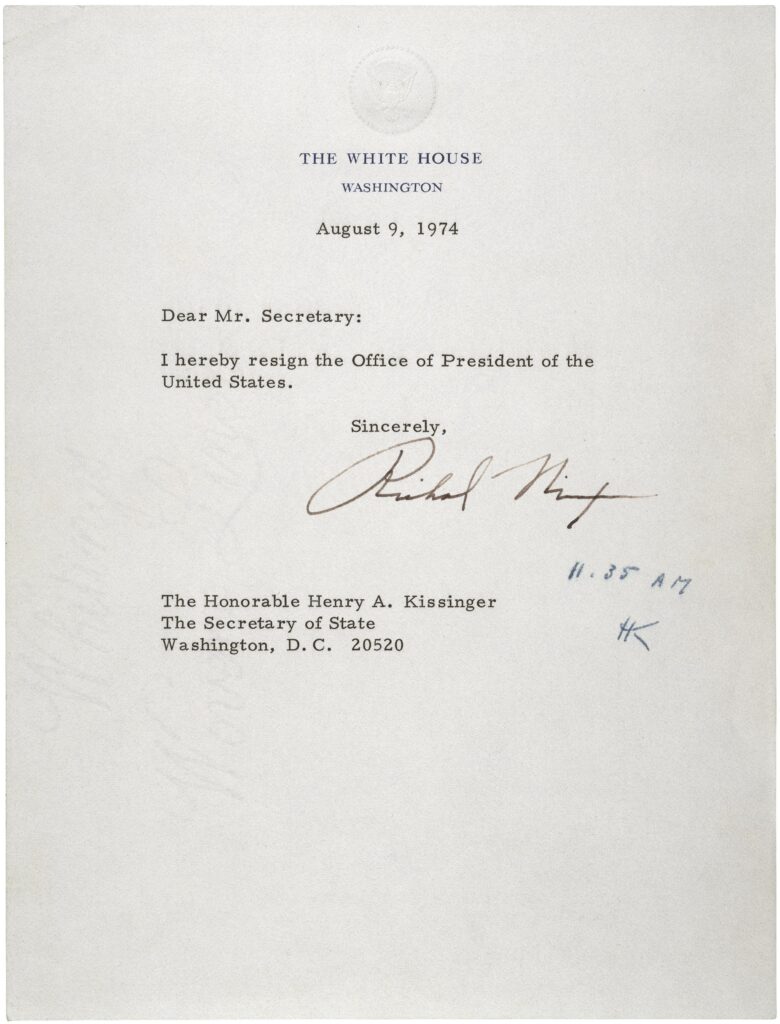In a historic televised address on the evening of August 8, 1974, President Richard M. Nixon declared his decision to resign, becoming the first president in U.S. history to do so. Facing imminent impeachment due to his role in the Watergate scandal, Nixon succumbed to the mounting pressure from the public and Congress to step down.
“By taking this action,” he stated in a somber speech from the Oval Office, “I hope that I will have hastened the start of the process of healing which is so desperately needed in America.”
The following day, just before noon, Nixon officially concluded his tenure as the 37th president of the United States. Departing from the White House lawn with his family aboard a helicopter, he offered a farewell smile and a mysterious victory or peace salute. As the helicopter door closed, the Nixon family began their journey back to San Clemente, California. Minutes later, Vice President Gerald R. Ford was inaugurated as the 38th president in the East Room of the White House.

After taking the oath of office, President Ford addressed the nation on television, proclaiming, “My fellow Americans, our long national nightmare is over.” He later issued a pardon for Nixon, aiming to heal the national rift caused by the Watergate scandal.
The scandal began on June 17, 1972, when five men, including a paid security coordinator for Nixon’s reelection committee, were arrested for breaking into and wiretapping the Democratic National Committee headquarters in the Watergate complex, Washington, D.C. Soon after, two former White House aides were implicated, but the Nixon administration denied involvement. Later that year, Washington Post reporters Carl Bernstein and Bob Woodward uncovered a high-level conspiracy, leading to a political scandal of unprecedented scale.

In May 1973, the Senate Select Committee on Presidential Campaign Activities, led by Senator Sam Ervin of North Carolina, commenced televised hearings on the growing Watergate affair. A week later, Harvard law professor Archibald Cox was appointed special Watergate prosecutor. During the hearings, former White House legal counsel John Dean testified that the break-in had been authorized by former Attorney General John Mitchell with the knowledge of White House advisers John Ehrlichman and H.R. Haldeman, and that Nixon was aware of the cover-up.
Meanwhile, Cox and his team unearthed extensive evidence of political espionage by Nixon’s reelection committee, illegal wiretapping of thousands of citizens by the administration, and political contributions to the Republican Party in exchange for favors.
In July, the existence of the Watergate tapes—official recordings of White House conversations between Nixon and his staff—was revealed. Cox subpoenaed these tapes, and after three months of delay, Nixon agreed to provide summaries, which Cox rejected.
In what became known as the Saturday Night Massacre on October 20, 1973, Nixon, in an unprecedented exercise of executive power, ordered Attorney General Elliot Richardson and Deputy Attorney General William Ruckelshaus to fire Cox. Both men refused and resigned in protest. Solicitor General Robert Bork then complied with Nixon’s order and dismissed Cox. Shortly after, the White House sent FBI agents to close the offices of the Special Prosecutor, Attorney General, and Deputy Attorney General.
Cox’s successor, Leon Jaworski, brought indictments against several top administration officials, including Mitchell and Dean, who were subsequently convicted. On November 14, 1973, U.S. District Judge Gerhard Gesell ruled that Cox’s dismissal had been illegal.
Public confidence in Nixon plummeted, and by late July 1974, the House Judiciary Committee had adopted three articles of impeachment: obstruction of justice, abuse of presidential powers, and hindrance of the impeachment process.

On July 30, under Supreme Court pressure, Nixon released the Watergate tapes. On August 5, transcripts were made public, including a recording of Nixon instructing Haldeman to obstruct the FBI’s investigation. Three days later, Nixon announced his resignation.












